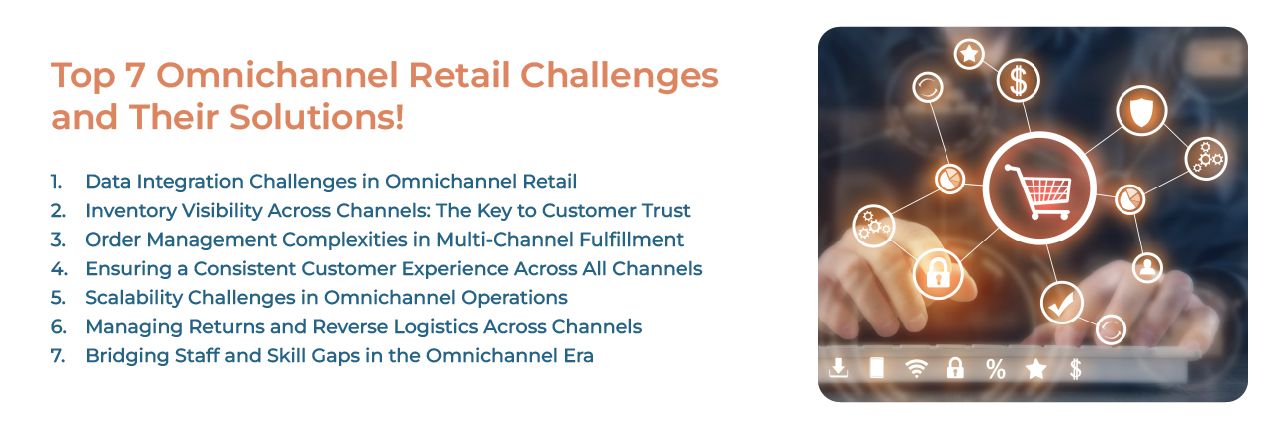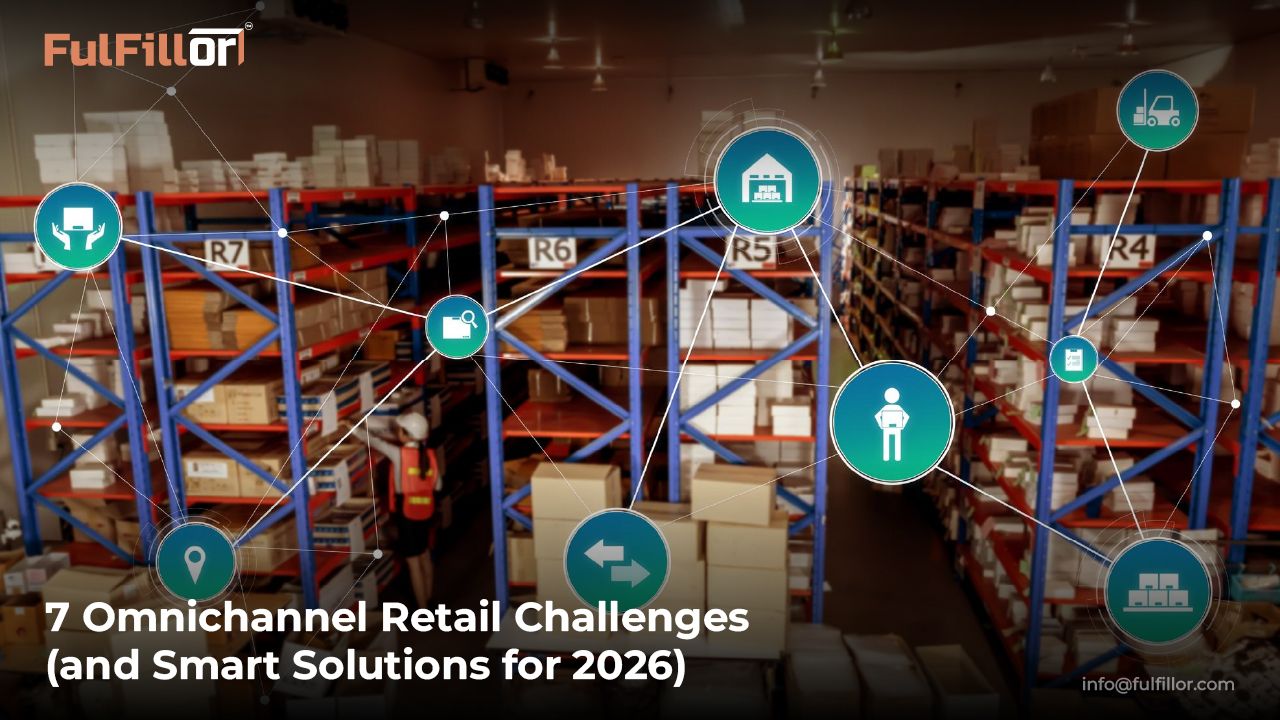7 Omnichannel Retail Challenges (and Smart Solutions for 2026)
The Rise of Omnichannel and Unified Commerce in 2026
In a fast-paced 2025 retail environment, delivering a friction-free shopping process and seamless omnichannel experience across multiple channels isn’t a nice-to-have; it’s a must-have.
Do you know 73% of shoppers prefer to shop across a variety of platforms in cross-channel retail? These statistics indicate that retailers must evolve with the changing demands of modern customers and focus more on omnichannel shopping and connected commerce. But despite the benefits, most of the companies have been facing serious challenges like inventory visibility issues that reflect lost sales and reduced/ eroded customer loyalty. Almost half of retailers have lost at least $1 million from omnichannel issues. But effectively fixing these problems can drive customer satisfaction and business performance. Recent research also revealed that those delivering a consistent omnichannel experience can keep almost 90% of their customers. This number strongly reinforces the value of this approach.
In this post, we will take a look at seven of the most prevalent omnichannel e-commerce challenges that retailers face and outline practical, proven ways to overcome them with success.
Top 7 Omnichannel Retail Challenges and Their Solutions!

1. Data Integration Challenges in Omnichannel Retail
-
Challenge: Retailers generally work with several systems, that don’t talk to each other, leading to data silos, integration latency, and misalignment of customer data across channels. This distortion results in mispricing, duplicate information, latency, and real-time data synchronization issues.
-
Solution: Consolidate all systems into a platform or middleware (or use a customer data platform / CDP) that uses APIs and syncs in real time. A single data ecosystem removes silos with complete precision and allows every department, from sales to fulfillment, to work with the same, trustworthy information. Not only does this help with efficiency, but it also develops trust on the part of the customer by creating a standard experience across the board.
2. Inventory Visibility Across Channels: The Key to Customer Trust
-
Challenge: When stock data is not synchronized across stores, warehouses, and online / marketplace channels, customers often encounter stockouts or incorrect availability, which results in lost sales and a poor experience.
-
Solution: Implement an instant data sync engine that updates inventory across all channels. Use multi-location inventory management or distributed inventory control systems. With live tracking and analytics, businesses get a full view of what’s available and where. This level of accuracy reduces over-promising, aids in the timing of replenishment, and ensures that what customers see online is always received, building trust and profitability.
3. Order Management Complexities in Multi-Channel Fulfillment
-
Challenge: Fulfilling multiple channel orders manually leads to confusion, slowdowns, and order errors. Without a centralized order management system (OMS), you’ll face routing errors, delayed order processing, and poor visibility into cross-channel orders.
-
Solution: Leverage a single, centralized OMS or unified order routing engine that captures and routes orders from all channels, including BOPIS (Buy Online Pick In Store), ship-from-store, marketplace, etc. This eventually translates to speedier processing, more accurate routing to the closest fulfillment center, and real-time tracking for customers. Automating the process end-to-end also lessens manual processing mistakes and results in smoother, more visible order journeys for businesses.
4. Ensuring a Consistent Customer Experience Across All Channels
-
Challenge: Shoppers demand that their user experience should be the same whether they’re on your site, in your store, or using a mobile application. Uneven branding, messaging, or pricing across channels breaks trust. Channel inconsistency also confuses customers when promotions differ or checkout workflows vary.
-
Solution: Create brand style guides, messaging frameworks, and a centralized content management system (CMS) to enforce consistency. Ensure experience is seamless across mobile, web, and in-store touchpoints. Be sure to familiarize and train employees on being consistent in tone, speed, and the quality of service. With connected systems and data sharing, each channel can provide the same seamless experience, one that is instantly recognizable, trusted, and fundamentally, genuinely customer-first.
5. Scalability Challenges in Omnichannel Operations
-
Challenge: As companies grow, or during seasonal spikes, older systems can’t always keep pace, which can lead to delays in meeting demand (or even errors and downtime). Legacy on-premise systems or monolithic software can’t scale under load or seasonal peaks, causing latency, downtime, or errors.
-
Solution: Adopt cloud infrastructure, microservices, or headless commerce frameworks that can expand elastically. Use AI for demand forecasting to allocate resources ahead of spikes. Forecasting for demand can be conducted through automation and AI tools to plan resources as needed. This flexibility enables your brand’s omnichannel operations to be fast, efficient, and agile as your business scales or markets change quickly.
6. Managing Returns and Reverse Logistics Across Channels
-
Challenge: Keeping track of returns across various channels can be messy and inconsistent. Without those real-time updates, returns can disappear into a black hole, refunds can be held up, and customers may lose faith in your store. Returns from online, in-store, and marketplace channels often vanish into black holes. Without real-time updates, inventory is off, refunds are delayed, and customers lose faith.
-
Solution: Use a returns management system or reverse logistics automation that ties into your OMS and WMS. Ensure restocked goods reenter the distributed inventory pool immediately. This keeps in check that returns are immediately reflected in the inventory system, maintaining accurate stock levels and accelerating turnaround times. A frictionless return process not only builds loyalty, but it turns post-purchase into a place where companies can retain customers.
7. Bridging Staff and Skill Gaps in the Omnichannel Era
-
Challenge: It's hard for staff to keep up with new technology or workflows that come with omnichannel selling. This lack of skill is likely to cause long lead times, as well as inconsistent service. Even the best systems fail if employees don’t know how to use them. Gaps in digital skills, change resistance, or lack of training slow down the adoption of new workflows like BOPIS or ship-from-store processes.
-
Solution: Regular, tactile training to help your staff understand the digital tools, order workflows, and omnichannel fulfillment methods of BOPIS and curbside pickup. Employ intuitive systems to enhance workflows and prevent mistakes. Well-trained, self-assured employees make for smooth business operations and dependable, excellent customer service, which is a crucial element for omnichannel success. Conduct omnichannel training programs, workshops, and cross-functional sessions. Promote upskilling, create in-app guidance, and simplify user interfaces so staff adapt faster.
Real-World Omnichannel Success with FulFillor’s 3PL WMS Here’s how a unified commerce platform (WMS + OMS integrated) delivers real results:
A major US online retailer was challenged by siloed order management and inventory synchronization, selling on multiple marketplaces and direct sales channels. When they began using FulFillor’s WMS and OMS, the company experienced a 30% increase in its fulfillment capacity and a decrease of at least 25% stock errors. The clients enjoyed the ability to monitor their deliveries and have a hassle-free return. This revolutionized their omnichannel activity, enabling strong growth and increased brand perception.
Turning Omnichannel Retail Challenges into Scalable Opportunities
Omnichannel retailing doesn’t have to be complex. With the right technology, challenges can be turned into simple operations, from accurately maintaining inventory to timely order fulfillment. Platforms like FulFillor naturally fit into a unified commerce ecosystem, offering real-time visibility, API-based integration, order routing intelligence, and reverse logistics automation. With the ability to manage inventory, orders, returns, and data in one centralized cloud infrastructure, retailers can deliver seamless omnichannel experiences and scale without friction.
Simplify your fulfillment and overcome omnichannel challenges with our dedicated, vivid, high-end 3PL WMS, FulFillor. Book a free tailored demo with our WMS professionals and discover how FulFillor can help you make your omnichannel operations feel both easy and scalable.
Omnichannel Retail FAQs
1. What do you mean by omnichannel selling?
- Omnichannel retailing is a concept that comes with the promise of frictionless shopping experiences across online, mobile, and in-store channels.
- Omnichannel selling means not just multichannel presence, but true systems integration, cross-channel consistency, unified customer data, and real-time synchronization across all touchpoints.
2. What are some common omnichannel retail challenges?
- Typical areas of difficulty include system integration, inventory visibility, order management, reverse logistics, and team training. These include data integration, inventory visibility, order management, reverse logistics, attribution & channel conflict, skill gaps, scalability, etc.
3. Why should you choose FulFillor for omnichannel retail management?
- FulFillor provides end-to-end integration, automation, real-time analytics, and powerful cloud infrastructures, which will help retailers maximize fulfillment & customer satisfaction. FulFillor provides APIs, a unified commerce platform, WMS, OMS, returns management, scalable architecture, and real-time sync — everything you need to run modern omnichannel.

